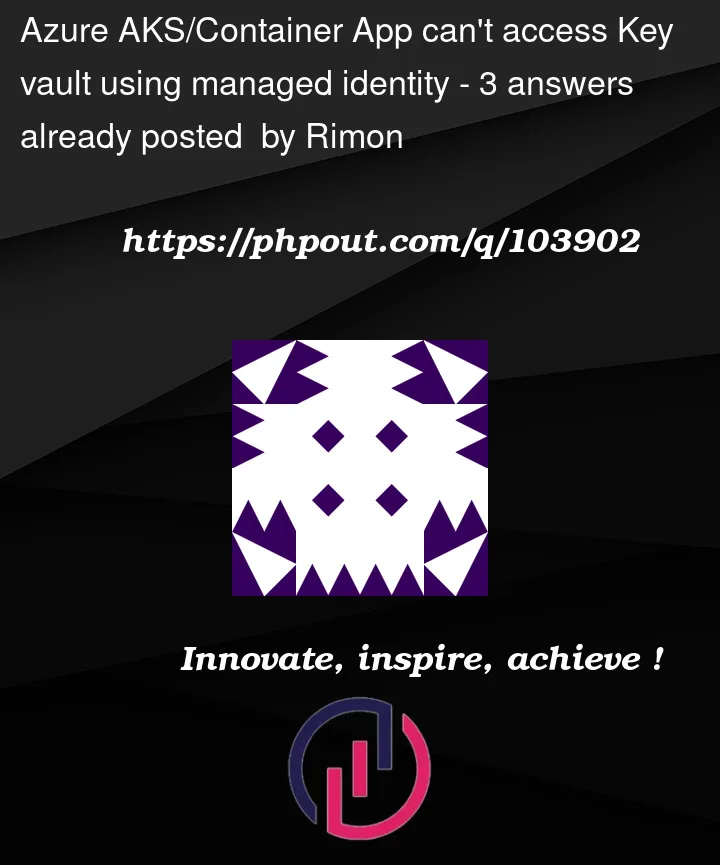I have a docker container python app deployed on a kubernetes cluster on Azure (I also tried on a container app). I’m trying to connect this app to Azure key vault to fetch some secrets. I created a managed identity and assigned it to both but the python app always fails to find the managed identity to even attempt connecting to the key vault.
The Managed Identity role assignments:
Key Vault Contributor -> on the key vault
Managed Identity Operator -> Managed Identity
Azure Kubernetes Service Contributor Role,
Azure Kubernetes Service Cluster User Role,
Managed Identity Operator -> on the resource group that includes the cluster
Also on the key vault Access policies I added the Managed Identity and gave it access to all key, secrets, and certs permissions (for now)
Python code:
credential = ManagedIdentityCredential()
vault_client = SecretClient(vault_url=key_vault_uri, credential=credential)
retrieved_secret = vault_client.get_secret(secret_name)
I keep getting the error:
azure.core.exceptions.ClientAuthenticationError: Unexpected content type "text/plain; charset=utf-8"
Content: no azure identity found for request clientID
So at some point I attempted to add the managed identity clientID in the cluster secrets and load it from there and still got the same error:
Python code:
def get_kube_secret(self, secret_name):
kube_config.load_incluster_config()
v1_secrets = kube_client.CoreV1Api()
string_secret = str(v1_secrets.read_namespaced_secret(secret_name, "redacted_namespace_name").data).replace("'", """)
json_secret = json.loads(string_secret)
return json_secret
def decode_base64_string(self, encoded_string):
decoded_secret = base64.b64decode(encoded_string.strip())
decoded_secret = decoded_secret.decode('UTF-8')
return decoded_secret
managed_identity_client_id_secret = self.get_kube_secret('managed-identity-credential')['clientId']
managed_identity_client_id = self.decode_base64_string(managed_identity_client_id_secret)
Update:
I also attempted to use the secret store CSI driver, but I have a feeling I’m missing a step there. Should the python code be updated to be able to use the secret store CSI driver?
# This is a SecretProviderClass using user-assigned identity to access the key vault
apiVersion: secrets-store.csi.x-k8s.io/v1
kind: SecretProviderClass
metadata:
name: azure-kvname-user-msi
spec:
provider: azure
parameters:
usePodIdentity: "false"
useVMManagedIdentity: "true" # Set to true for using managed identity
userAssignedIdentityID: "$CLIENT_ID" # Set the clientID of the user-assigned managed identity to use
vmmanagedidentityclientid: "$CLIENT_ID"
keyvaultName: "$KEYVAULT_NAME" # Set to the name of your key vault
cloudName: "" # [OPTIONAL for Azure] if not provided, the Azure environment defaults to AzurePublicCloud
objects: ""
tenantId: "$AZURE_TENANT_ID"
Deployment Yaml
apiVersion: apps/v1
kind: Deployment
metadata:
name: backend
namespace: redacted_namespace
labels:
app: backend
spec:
replicas: 1
selector:
matchLabels:
app: backend
template:
metadata:
labels:
app: backend
spec:
containers:
- name: backend
image: redacted_image
ports:
- name: http
containerPort: 80
- name: https
containerPort: 443
imagePullPolicy: Always
resources:
# You must specify requests for CPU to autoscale
# based on CPU utilization
requests:
cpu: "250m"
env:
- name: test-secrets
valueFrom:
secretKeyRef:
name: test-secrets
key: test-secrets
volumeMounts:
- name: test-secrets
mountPath: "/mnt/secrets-store"
readOnly: true
volumes:
- name: test-secrets
csi:
driver: secrets-store.csi.k8s.io
readOnly: true
volumeAttributes:
secretProviderClass: "azure-kvname-user-msi"
dnsPolicy: ClusterFirst
Update 16/01/2023
I followed the steps in the answers and the linked docs to the letter, even contacted Azure support and followed it step by step with them on the phone and the result is still the following error:
"failed to process mount request" err="failed to get objectType:secret, objectName:MongoUsername, objectVersion:: azure.BearerAuthorizer#WithAuthorization: Failed to refresh the Token for request to https://<RedactedVaultName>.vault.azure.net/secrets/<RedactedSecretName>/?api-version=2016-10-01: StatusCode=400 -- Original Error: adal: Refresh request failed. Status Code = '400'. Response body: {"error":"invalid_request","error_description":"Identity not found"} Endpoint http://169.254.169.254/metadata/identity/oauth2/token?api-version=2018-02-01&client_id=<RedactedClientId>&resource=https%3A%2F%2Fvault.azure.net"




3
Answers
I finally figured it out, I contacted microsoft support and it seams Aks Preview is a bit buggy "go figure". They recommended to revert back to a stable version of the CLI and use user assigned identity.
I did just that but this time, instead of creating my own identity that I would then assign to both the vault and the cluster as this seams to confuse it. I used the the identity the cluster automatically generates for the nodes.
Maybe not the neatest solution, but it's the only one that worked for me without any issues.
Finally, some notes missing from the Azure docs: Since the CSI driver mounts the secrets as files in the target folder, you still need to read those files yourself to load them as env variables.
For example in python:
What you are referring to is called pod identity (recently deprecated for workload identity).
if the cluster is configured with managed identity, you can use workload identity.
However, for AKS I suggest configuring the secret store CSI driver to fetch secrets from KV and have them as k8s secrets. To use managed identity for secret provider, refer to this doc.
Then you can configure your pods to read those secrets.
Using the Secrets Store CSI Driver, you can configure the
SecretProviderClassto use a workload identity by setting theclientIDin theSecretProviderClass. You’ll need to use the client ID of your user assigned managed identity and change theusePodIdentityanduseVMManagedIdentitysetting tofalse.With this approach, you don’t need to add any additional code in your app to retrieve the secrets. Instead, you can mount a secrets store (using CSI driver) as a volume mount in your pod and have secrets loaded as environment variables which is documented here.
This doc will walk you through setting it up on Azure, but at a high-level here is what you need to do:
EnableWorkloadIdentityPreviewfeature using Azure CLIazure-keyvault-secrets-provideradd-on enabled and--enable-oidc-issuerand--enable-workload-identiyflags setServiceAccountwith annotations and labels that enable this for Azure workload identitySecretProviderClassusingclientIDto use workload identity and adding asecretObjectsblock to enable syncing objects as environment variables using Kubernetes secret store.Deploymentwith alabelto use workload identity, theserviceAccountNameset to the service account you created above, volume using CSI and the secret provider class you created above, volumeMount, and finally environment variables in your container usingvalueFromandsecretKeyRefsyntax to mount from your secret object store.Hope that helps.